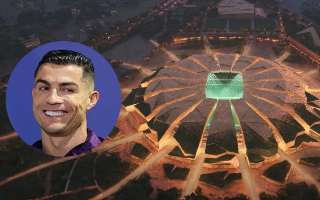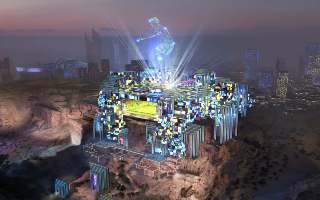Prince Mohammed bin Salman Stadium
| Capacity | 45 000 |
|---|---|
| Country | Saudi Arabia |
| City | Riyadh |
| Clubs | Al-Nassr FC, Al-Hilal Saudi FC |
| Category | Design being implemented |
| Cost | SAR 4 B ($1.07 B) |
| Construction | 2024–2029 |
| Design | Populous |
Advertisement
Prince Mohammed bin Salman Stadium – design description
How did plans to build a new stadium in Qiddiya come about?
What is Qiddiya?
In 2017, a project called Qiddiya was announced, one of the huge projects to be implemented as part of the Saudi Vision 2030 programme. In 2018, the Qiddiya Investment Company, owned by the Public Investment Fund, was established to carry out the investment. In 2019, the start of the project was announced.
The Qiddiya megaproject comprises a massive entertainment complex to be built less than 50 km west of Riyadh, the capital of Saudi Arabia. The complex will be located in the Tuwaiq mountains, in a valley surrounded on three sides by high cliffs. It will include theme parks, hotels, shopping centers and even a Formula One circuit.
When were the plans for the stadium at Qiddiya conceived?
Also planned as part of Qiddiya was a sports center to be built above the valley, on the edge of a 200-meter-high cliff. The complex was to include a sports hall and water sports center. The centerpiece of the resort was to be a football stadium. The design of the stadium was created in 2019 by the renowned design studio Populous.
What were the original plans for the new stadium in Qiddiya?
The facility was to be built on the edge of a steep cliff, without a stand on the eastern side, so that a part of the audience would get a view of the valley. The stadium was to be covered by an oval roof with a mirrored underside. The facility was also to be cooled.
Why were plans for a new stadium in Qiddiya modified?
The stadium project was part of Saudi Arabia's bid to host the 2027 Asian Cup, with a capacity of around 22,000, although there were also reports that the venue would hold 40,000, making it suitable for World Cup matches, which Saudi Arabia wanted to host jointly with Egypt and Greece in 2030 and, after that initiative failed, on its own in 2034.
In early 2023, Saudi Arabia was awarded the right to host the 2027 Asian Cup, and the new stadium in Qiddiya was confirmed as one of the venues for the tournament. In addition, in October 2023, it emerged that Saudi Arabia's bid to host the 2034 World Cup was the only one submitted and the country will host the tournament.
The awarding of the organization of the World Cup was a significant boost for the new stadium project in Qiddiya. At the end of 2023, a tender process was launched to select the main contractor for the venue, and in January 2024 new significantly modified plans for the new arena, again prepared by Populous, were presented.
What changes has the new Qiddiya stadium design brought?
The updated design carries a radical change in the appearance of the stadium and an increase in capacity to 45,000 spectators. However, the characteristic opening on the west side overlooking the valley has been retained. The presentation of the new design also revealed the new name of the venue, which is to be named after Saudi Arabia's crown prince and prime minister, Mohammed bin Salman.
What will Prince Mohammed bin Salman Stadium be like?
The facility will be built right on the edge of a cliff. The unusual topographical location has been exploited by the architects, who have opted out of building stands on the west side so that spectators can enjoy a panoramic view of the valley. On the other sides, three-storey stands with a capacity of 45,000 spectators will be built.
The exterior design features LED screen-covered cubes and tall, rectangular portals that contribute to the unconventional, futuristic image of the arena. The stadium will feature modern and expensive technology, including a retractable roof and pitch, as well as state-of-the-art holographic and telecommunication technology.
The huge opening on the west side will also be able to be closed off, creating a large LED wall that can be used, for example, to display movies, live broadcasts or for e-sports competitions.
The stadium will be equipped with an ecological cooling system, which will include an underground water reservoir and underground air passages.
Its unusual location, edgy design, multifunctionality and modern technology will make the stadium a unique piece of architecture, setting new directions in the development of sports arenas.
How will Prince Mohammed bin Salman Stadium be used?
A multitude of functions and technologies will make the stadium a multifunctional arena that can host a range of events and cultural activities in addition to football matches. The conversion between the different modes of operation is expected to take a maximum of a few hours and allow separate events with a different profile to be organized in a single day.
One of the main ideas of the project is the possibility of using the facility for e-sports competitions. In December 2023, the Gaming & Esports District project was announced as part of Qiddiya City, with a building dedicated to e-sports. A complimentary stadium, equipped with state-of-the-art technology, will further enrich this offer and make Qiddya a real mecca for gamers and e-sports fans.
The primary role of the stadium, however, will be to host football matches. The venue has been designated to be one of the venues for major international events held in Saudi Arabia: Asian Cup 2027 and the 2034 World Cup, as well as being used for the 2034 Asian Games to be held in Riyadh.
In early 2022, a partnership was announced with two leading Riyadh-based clubs, Al-Hilal and Al-Nassr, who are expected to play their matches at the stadium once it is operational. The stadium is also expected to host other significant fixtures, such as King's Cup finals and national team matches.
When will the Prince Mohammed bin Salman Stadium be built?
The bidding process to select the main contractor for the facility began in late 2023. In October 2024, it was announced that a consortium consisting of Spain's FCC Construcción and local Nesma & Partners was the winner of the tender. The value of the contract is 4 billion rials.
The first work on the construction of the stadium began in late 2024. The stadium is expected to be ready in 2029 and, contrary to initial assumptions, will not be one of the venues of the 2027 Asian Cup.
Advertisement
Renderings
-

2024 © Populous 
2024 © Populous 
2024 © Populous 
2024 © Populous 
2024 © Populous 
2024 © Populous 
2024 © Populous 
2024 © Populous 
2024 © Populous 
2024 © Populous 
2024 © Populous 
2024 © Populous 
2024 © Populous 
2024 © Populous 
2024 © Populous 
2024 © Populous 
2024 © Populous 
2024 © Populous 
2024 © Populous 
2024 © Populous 
2024 © Populous 
2019 © Populous 
2019 © Populous 
2019 © Populous 
2019 © Populous
2019:
Related news
2024
-

Ronaldo: Stadiums for the 2034 World Cup? “The best tournament in history”
In 2030, the FIFA World Cup will make its way to Portugal, among other countries. Yet, Al-Nassr’s superstar, Cristiano Ronaldo, has already sparked controversy—likely not without a price tag—by declaring that the tournament in Saudi Arabia will be the best in history. Ronaldo also praised the stadiums, though at this point, they don’t even exist.
-

Saudi Arabia: Spanish company to build 2034 World Cup stadium
The Spanish company FCC, in a consortium with the local firm Nesma & Partners, has secured a contract worth over €3.6 billion to build Prince Mohammed Bin Salman Stadium, one of the venues proposed for the 2034 World Cup.
-

Saudi Arabia: Saudis unveil amazing stadiums for 2034 FIFA World Cup
Saudi Arabia has officially released details of the 2034 World Cup. The presentation took place in Paris, where plans to use state-of-the-art stadiums in five cities were shown. Will Saudi Arabia manage to square their bid with the international football community?
-

News of the week: Fight for World Cup final, Latino disputes, Arab wonder
What's been going on in the stadium world for the last week? England has not escaped trouble and damage, the World Cup final is still being battled out in the USA, while South America is dominated by disputes and uncertainty. We will cover all this and much more in a new format on our website, News of the Week.
-

Saudi Arabia: 'Future wonder of the world' on its way?
The Las Vegas of sport. That's what Qiddiya’s sports supercity project can be called. Even being hostile towards Saudi Arabia, it's hard not to lose your breath at the sight of the new renderings of Prince Mohammed Bin Salman Stadium. So what is happening on the construction site?
2023
-

Saudi Arabia: Supercity project returns in new version
The Saudi sports city is making a comeback. The Qiddiya project was first introduced in 2018 and was meant to reflect the ambitions of Crown Prince Mohammed Bin Salman, but these plans were hampered by delays. However, with Saudi Arabia being selected as host s of the 2034 World Cup, the supercity plan has returned in an enhanced edition.
-

World Cup 2034: Host of the tournament announced
There was no doubt that football's 2034 World Cup is scheduled to take place in Asia and/or Oceania. FIFA encouraged all federations from this part of the world to submit their candidatures. The deadline for applying was the end of October and only one application was eventually received. The candidature has now been approved.
-

2027 Asian Cup: Confusion over selection of tournament host
On December 3, 2019, the AFC announced the start of the process of selecting the host of the 2027 Asian Cup. Federations interested in hosting the tournament had until March 31, 2020 to submit their candidacies, due to the COVID-19 pandemic, a deadline that has been postponed several times. Several years later, we know both the country and the stadiums that will host the tournament.
 StadiumDB
StadiumDB